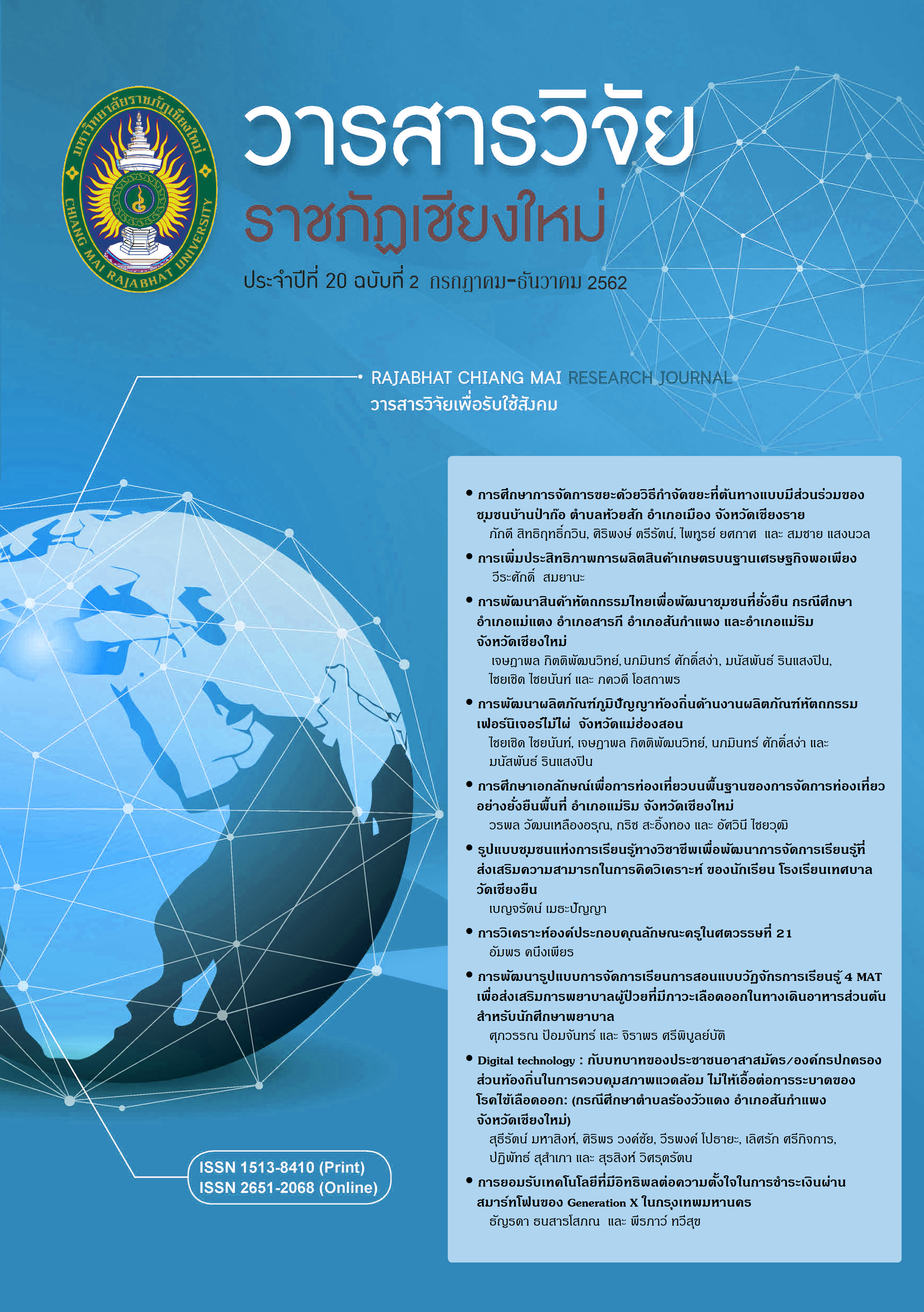การพัฒนาสินค้าหัตถกรรมไทยเพื่อพัฒนาชุมชนที่ยั่งยืน กรณีศึกษา อำเภอแม่แตง อำเภอสารภี อำเภอสันกำแพง และอำเภอแม่ริม จังหวัดเชียงใหม่
DOI:
https://doi.org/10.14456/rcmrj.2019.160088คำสำคัญ:
การพัฒนาสินค้าหัตถกรรมไทย, ชุมชนที่ยั่งยืนบทคัดย่อ
การพัฒนาสินค้าหัตถกรรมไทยเพื่อพัฒนาชุมชนที่ยั่งยืน กรณีศึกษา อำเภอแม่แตง อำเภอสารภี อำเภอสันกำแพง และอำเภอแม่ริม จังหวัดเชียงใหม่ มีวัตถุประสงค์ 1) เพื่อออกแบบและพัฒนาผลิตภัณฑ์หัตถกรรมของจังหวัดเชียงใหม่ จำนวน 4 อำเภอ 2) เพื่อประเมินความพึงพอใจผลิตภัณฑ์หัตถกรรมที่เกิดจากการพัฒนาผลิตภัณฑ์หัตถกรรมใหม่ของจังหวัดเชียงใหม่ จำนวน 4 อำเภอ ในการดำเนินงานวิจัยได้ทำการเก็บข้อมูลตัวอย่างผลิตภัณฑ์เดิม กระบวนการทำผลิตภัณฑ์ โดยนำแนวทางด้านการออกแบบมาคิดมาวิเคราะห์ และพัฒนาผลิตภัณฑ์ตามความต้องการของกลุ่มตัวอย่างและผู้บริโภค โดยการนำจุดเด่นของผลิตภัณฑ์ทั้ง 4 กลุ่ม มาออกแบบเพื่อให้ได้แนวทางพัฒนาสินค้าหัตถกรรม และประเมินความต้องการรูปแบบผลิตภัณฑ์ จำนวน 80 คน พบว่าในด้านความสวยงาม สี ลวดลาย รวม 25 คน โดยคิดเป็นร้อยละ 31.25 มีความต้องการมากที่สุด และได้ประเมินจากกลุ่มตัวอย่าง จํานวน 248 คน เพื่อประเมินความพึงพอใจผลิตภัณฑ์หัตถกรรม
ผลการวิจัย พบว่า ระดับความพึงพอใจด้านรูปแบบของผลิตภัณฑ์ ของผลิตภัณฑ์กลุ่มหัตถกรรมบ้านหนองตอง อำเภอแม่แตง มีค่าเฉลี่ยอยู่ที่ ระดับมาก มีค่าเฉลี่ย 4.36 ส่วนเบี่ยงเบนมาตรฐาน 0.15 ระดับความพึงพอใจด้านรูปแบบของผลิตภัณฑ์ กลุ่มวิสาหกิจชุมชนกลุ่มแผกหลวง อำเภอแม่ริม มีค่าเฉลี่ยอยู่ที่ ระดับมากที่สุด มีค่าเฉลี่ย 4.50 ส่วนเบี่ยงเบนมาตรฐาน 0.17 ระดับความพึงพอใจด้านรูปแบบของผลิตภัณฑ์ กลุ่มวิสาหกิจชุมชน บ้านป่าปงหลวง อำเภอสารภี มีค่าเฉลี่ยอยู่ที่ระดับมาก มีค่าเฉลี่ย 4.21 ส่วนเบี่ยงเบนมาตรฐาน 0.13 ระดับความพึงพอใจด้านรูปแบบของผลิตภัณฑ์ กลุ่มวิสาหกิจชุมชน อำเภอสันกำแพง จังหวัดเชียงใหม่มีค่าเฉลี่ยอยู่ที่ระดับมากที่สุด มีค่าเฉลี่ย 4.68 ส่วนเบี่ยงเบนมาตรฐาน 0.09
Downloads
เอกสารอ้างอิง
ธีระชัย สุขสด. (2544). การออกแบบผลิตภัณฑ์อุตสาหกรรม. กรุงเทพฯ: โอ.เอส.พริ้นติ้ง เฮาส์.
นวลน้อย บุณวงค์.(2539). หลักการออกแบบ. กรุงเทพฯ: จุฬาลงกรณ์มหาวิทยาลัย.
มนัสพันธ์ รินแสงปิน, เจษฎาพล กิตติพัฒนวิทย์, นภมินทร์ ศักดิ์สง่า, และไชยเชิด ไชยนันท์. (2560). การศึกษาข้อมูลด้านศิลปหัตถกรรมของชนเผ่าต่าง ๆ เพื่อการพัฒนาผลิตภัณฑ์งานจักสานเพื่อการพาณิช อำเภอแม่สะเรียง จังหวัดแม่ฮ่องสอน. วารสารวิจัยราชภัฏเชียงใหม่, 18(2), 50-58.
วิบูลย์ ลี้สุวรรณ. (2539). ศิลปหัตถกรรมพื้นบ้าน. พิมพ์ครั้งที่ 4. กรุงเทพฯ: บริษัทต้นอ้อ แกรมมี่จำกัด.
ศรีสุดา ลีลาสุวัฒน์ และคณะ. (2558). แนวทางการพัฒนาการตลาด OTOP สู่สากล อำเภอสามพราน จังหวัดนครปฐม. มหาวิทยาลัยเทคโนโลยีราชมงคลรัตนโกสินทร์.
ดาวน์โหลด
เผยแพร่แล้ว
รูปแบบการอ้างอิง
ฉบับ
ประเภทบทความ
สัญญาอนุญาต
1. บทความ ข้อมูล เนื้อหา รูปภาพ ฯลฯ ที่ได้รับการตีพิมพ์ใน “Community and Social Development Journal” ถือเป็นลิขสิทธิ์ของ Community and Social Development Journal มหาวิทยาลัยราชภัฏเชียงใหม่ และเพื่อให้เผยแพร่บทความได้อย่างเหมาะสมผ่านสื่อสิ่งพิมพ์และอิเล็กทรอนิกส์ ผู้เขียนยังคงถือครองลิขสิทธิ์บทความที่ตีพิมพ์ภายใต้ใบอนุญาต Creative Commons Attribution (CC BY) ซึ่งอนุญาตให้เผยแพร่บทความซ้ำในแหล่งอื่นได้ โดยอ้างอิงต้องอ้งอิงบทความในวารสาร ผู้เขียนต้องรับผิดชอบในการขออนุญาตผลิตซ้ำเนื้อหาที่มีลิขสิทธิ์จากแหล่งอื่น
2. เนื้อหาบทความที่ปรากฏในวารสารเป็นความรับผิดชอบของผู้เขียนบทความโดยตรง ซึ่งกองบรรณาธิการวารสารไม่จำเป็นต้องเห็นด้วยหรือร่วมรับผิดชอบใดๆ














